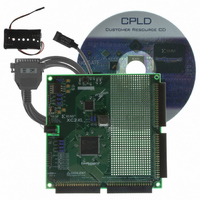DO-CPLD-DK-G Xilinx Inc, DO-CPLD-DK-G Datasheet - Page 21

DO-CPLD-DK-G
Manufacturer Part Number
DO-CPLD-DK-G
Description
KIT DESIGN CPLD W/BATT HOLDER
Manufacturer
Xilinx Inc
Series
CoolRunner™- IIr
Type
CPLDr
Specifications of DO-CPLD-DK-G
Contents
Proto Board, Download Cable, Samples, Software
For Use With/related Products
CoolRunner-ll, XC9500XL
Lead Free Status / RoHS Status
Lead free / RoHS Compliant
Other names
122-1512
Available stocks
Company
Part Number
Manufacturer
Quantity
Price
CoolRunner-II Low-Power CPLDs
Programmable Logic Design
June 12, 2006
Selection Considerations
R
To decide which device best meets your design criteria, take a minute to jot down your
design specs (using the list below as a criteria reference). Next, go to a specific product
family page to get more detailed information about the device you need.
Density – Each part gives an equivalent “gate count,” or estimate of the logic density of the
part.
Number of Registers – Count up the number of registers you need for your counters, state
machines, registers, and latches. The number of macrocells in the device must be at least
this large.
Number of I/O Pins – How many inputs and outputs does your design need?
Speed Requirements – What is the fastest combinatorial path in your design? This will
determine the Tpd (in nanoseconds) of the device. What is the fastest sequential circuit in
your design? This will tell you what fMax you need.
Package – What electromechanical constraints are you under? Do you need the smallest
ball grid array package possible, or can you use a more ordinary QFP? Or are you
prototyping and need to use a socketed device, such as a PLCC package?
Low Power – Is your end product battery- or solar-powered? Does your design require the
lowest power devices possible? Do you have heat dissipation concerns?
System-Level Functions – Does your board have multi-voltage devices? Do you need to
level shift between these devices? Do you need to square up clock edges? Do you need to
interface to memories and microprocessors?
CoolRunner -II CPLDs combine very low power with high speed, high density, and high
I/O counts in a single device. The CoolRunner-II family ranges in density from 32 to 512
macrocells. CoolRunner -II CPLDs feature RealDigital technology, allowing the devices to
draw virtually no power in standby mode. This makes them ideal for the fast-growing
market of battery-operated portable electronic equipment, such as:
•
•
•
•
•
These CPLDs also use far less dynamic power during actual operation compared to
conventional CPLDs, an important feature for high-performance, heat- sensitive
equipment such as telecom switches, video conferencing systems, simulators, high-end
testers, and emulators.
Laptop PCs
Telephone handsets
Personal digital assistants
Electronic games
Web tablets
Sense amplifier 0.25mA each - Standby
Sense amplifier 0.25mA each - Standby
A
A
Larger R = slower response
Larger R = slower response
Turbo vs Non Turbo
Turbo vs Non Turbo
Higher I
Higher I
& less power
& less power
B
B
Figure 2-2: Sense Amplifier vs. CMOS CPLDs
CC
CC
at Fmax
at Fmax
C
C
www.xilinx.com
Vcc
Vcc
RealDigital: CMOS Everywhere - Zero Static Power
RealDigital: CMOS Everywhere - Zero Static Power
RealDigital: CMOS Everywhere - Zero Static Power
A
A
A
B
B
B
C
C
C
D
D
D
CoolRunner-II Low-Power CPLDs
11





















